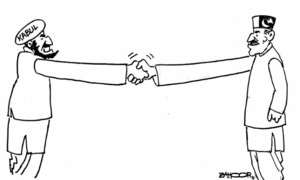TWO Hindu sisters, Reena and Raveena, were reportedly abducted recently from their home in Daharki and taken to Rahim Yar Khan. This is yet another in a series of such abductions taking place in Sindh’s rural areas of Umerkot, Tharparkar and Ghotki in which economically vulnerable Hindu girls or young women of marriageable age are ‘abducted’ and then conveniently discovered with their newfound identity as converts to Islam. The ensuing public hue and cry fizzles out after a few days.
I am a police officer serving in Balochistan’s southern district of Lasbela. In my subdivision, eight per cent of the population is Hindu, and there is enviable inter-communal harmony here. It has been so for centuries — people of all religions living together in a spirit of acceptance and mutual respect. In fact, many Muslims enthusiastically participated in the recent Holi celebrations. Such sentiments are invariably reciprocated by the Hindus.
In the context of the recent incident, three fundamental questions arise. Why are Hindus in Balochistan not being subjected to forced conversions? Why is this phenomenon so predominant in interior Sindh? And lastly, why is the modus operandi — a Hindu female, either minor or of marriageable age, eloping with a man and then converting to Islam — identical in all such incidents?
What makes Hindus in Sindh so vulnerable?
To answer the first question, Hindus in Balochistan have always felt more secure vis-à-vis religious persecution. The tribal chiefs consider Hindus, or for that matter any other religious minority, as members of their own extended family and afford them the freedom to live their lives according to their faith. They never acquired any missionary zeal to convert them. The Jams of Lasbela and Bugti tribal chiefs in Dera Bugti, for instance, have always been protective of them. Owing to this, society overall has developed a culture of tolerance and coexistence.
Second, Hindu places of worship are proportionate to their population: within the jurisdiction of two police stations (Uthal and Bela) in Lasbela, for example, there are 18 temples for 5,000 Hindus living in the area. This is a powerful indicator of religious freedom.
Lastly, Hindus are economically well off: they are working as contractors, bank employees and landowners. By virtue of their affluence, they enjoy a social status that gives them adequate protection.
On the other hand, the dynamics in interior Sindh are altogether different.
For one, the social and economic disparities are stark. It is a particularly inegalitarian society, where a few individuals enjoy a privileged status and the impunity that goes with it while others have to struggle for even their basic rights to be recognised. The Hindu community’s lack of financial empowerment, and their total dependence on those who control the means of production, makes them doubly vulnerable.
Second, there is a very strong proselytising zeal among the local clergy to bring non-Muslims into the fold of the dominant faith. To convert someone is perceived as a pious deed that will bring rewards in the hereafter, no matter the method employed to execute the conversion. Clerics like Mian Mitho from Ghotki and Ayub Jan Sarhandi from Samaro, to name a few, have become veritable symbols of conversion in Sindh.
Third, for a poor Hindu girl, conversion is in a way a stepping stone to a better life that offers her the prospect of an end to a miserable existence. Such considerations have played a role in young girls being enticed by even elderly Muslim men into marrying the latter.
Fourth, elopement in the case of a Hindu girl is akin to defilement. After running away from her family, she sees no way back because she will be shunned by her own community. Thus even if she is remorseful and unhappy in her marriage, she will accept her lot.
In the backdrop of these recurring incidents, the police must expand their outreach to the vulnerable Hindu community. They should meet often not only with the notables of the community, but also local Hindus who do not have any social media platform from where to voice their concerns.
For most of Pakistan’s existence, there existed no legislation on a registration mechanism for Hindu marriages. Then the Sindh Hindus Marriage Act, 2016 was passed by the Sindh Assembly which, however, includes no provision for divorce.
A year later, the National Assembly enacted the Hindu Marriage Act, 2017, which is applicable to all the provinces except Sindh. Although it frames a comprehensive process for the verification and registration of marriages, clause 12(3) gives leeway to forced conversions by stating that a Hindu marriage can be terminated on the grounds that the other party “has ceased to be Hindu by conversion to another religion”. Such anomalies should be rectified through amendments, if the practice of forced conversions is to be eliminated.
The writer is a police officer posted in Balochistan.
akhlaqtarar5959@gmail.com
Published in Dawn, March 31st, 2019










































